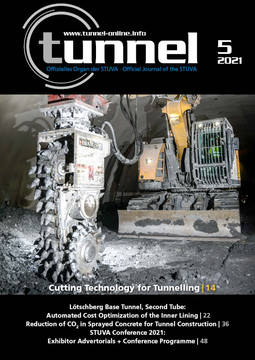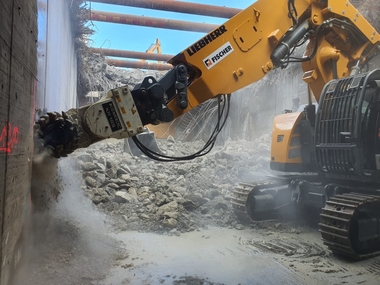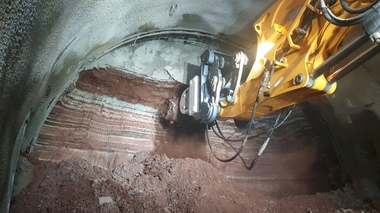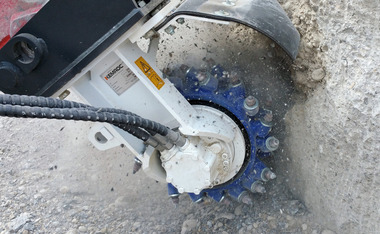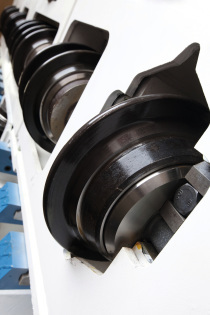Cutting Technology for Tunnelling
Excavator-mounted cutting attachments have become established in tunnel projects of the Austrian construction group Porr and in other construction companies. The wide range of applications is carried out with both standard and special cutters. In some cases, even excavation of the tunnel is carried out using cutting technology. In soft rock, this offers an advantage over blasting, because the bedrock is not damaged by vibrations. Moreover, numerous other operations in tunnel construction and rehabilitation are made possible by excavator-mounted cutting attachments.
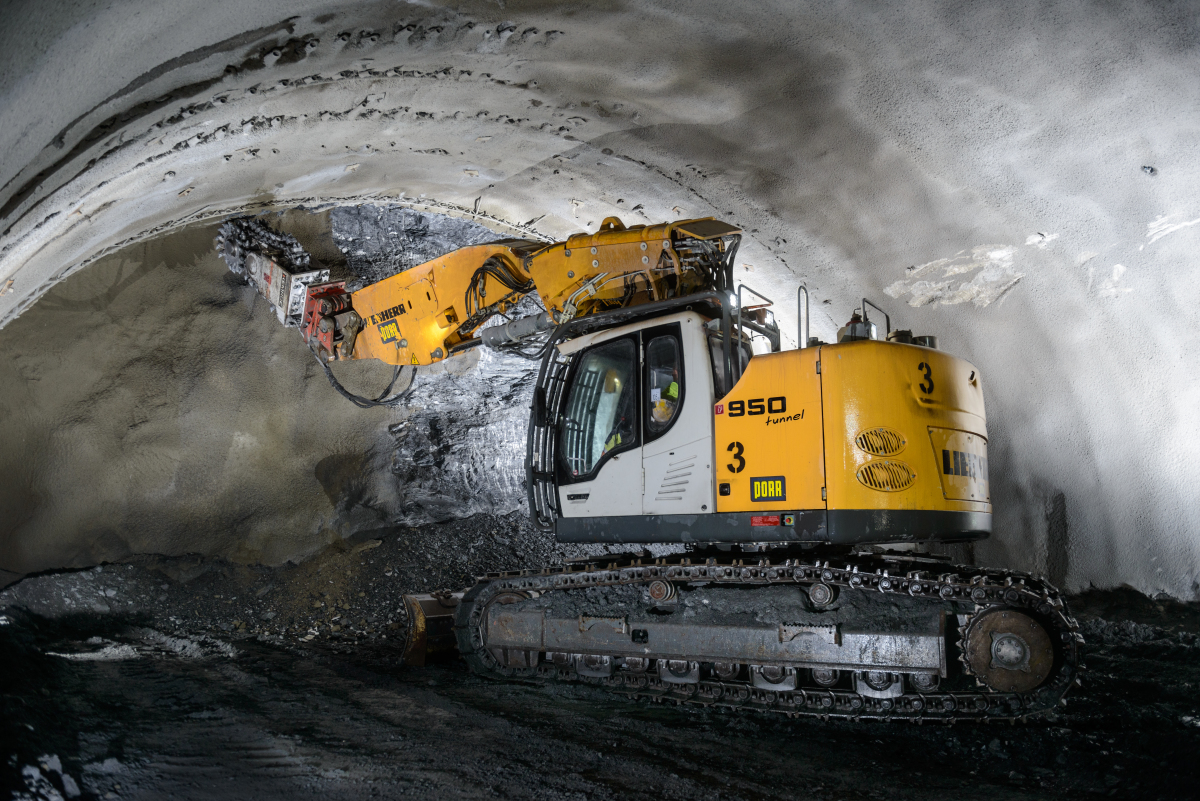 On the northern sections of a motorway tunnel in Poland, Porr is using a tunnel excavator with a chain cutter attachment for excavation works
On the northern sections of a motorway tunnel in Poland, Porr is using a tunnel excavator with a chain cutter attachment for excavation works
Credit/Quelle: KEMROC/Thomas Exel
Cutting technology is playing an increasingly important role in the tunnel projects of the Austrian construction company Porr. It is currently also being used for a major infrastructure project in Poland. Porr has been commissioned with the planning and construction of the 16 km long section III Bolków–Kamienna Góra of the S3 motorway. In future, the S3 will form one of the three pillars of the Polish road network from the north to the south, alongside the A1 and the S19, and will connect the Baltic port of Swinoujscie with the Czech Republic and Austria. One of the most complex engineering tasks on construction section III, planned and executed in cooperation between Porr S.A. (Warsaw) and Porr Bau GmbH (Vienna), is the construction of a 2300 m long twin-tube road tunnel. These will be excavated from both sides. Tunnelling started on 4 December 2020, and by the end of July 2021 the excavation was about halfway advanced.
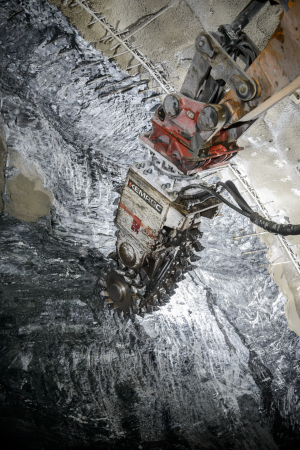 The excavator-cutter combination achieves an economical tunnelling performance with low vibrations in soft shale
The excavator-cutter combination achieves an economical tunnelling performance with low vibrations in soft shale
Credit/Quelle: KEMROC/Thomas Exel
Cutting in Shale
While there are hard mineral conglomerates in the southern tunnel sections, which are loosened by blasting, soft shale rocks dominate in the north. Here, vibrations caused by blasting could damage the bedrock. This must be avoided as far as possible, however, as the Porr tunnellers are using the New Austrian Tunnelling Method (NATM), which involves using the rock surrounding the cavity as a load-bearing component. For this reason, it was decided to use tunnel excavators and cutting attachments for the excavation. A total of five cutters are in use in the two northern tube sections of the S3 road tunnel: four standard rotary drum cutters from Porr‘s machine fleet and one EK 140_800 chain cutter (rated power 140 kW, working width 800 mm) from the German manufacturer Kemroc.
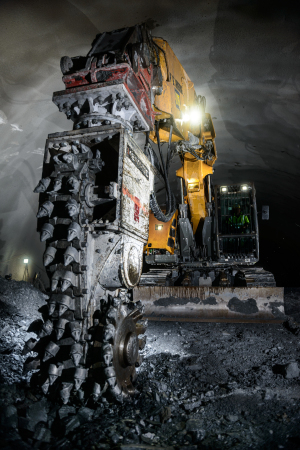 A rotating cutter chain with tungsten carbide tipped picks is the essential feature of Kemroc chain cutters. It enables rock to be removed without leaving any residue
A rotating cutter chain with tungsten carbide tipped picks is the essential feature of Kemroc chain cutters. It enables rock to be removed without leaving any residue
Credit/Quelle: KEMROC/Thomas Exel
Unlike conventional rotary drum cutters, Kemroc EK series chain cutters have a rotating cutter chain fitted with tungsten carbide tipped picks between the lateral cutter heads. They save up to 40% energy compared to comparable excavator-mounted cutting attachments without a central chain. Together with the newly introduced EK 220 model (220 kW), the EK product range now fits excavators from 1.5 to 70 t operating weight. Kemroc‘s range is complemented by rotary drum cutters/twin head cutters without a central rotating cutter chain. According to Kemroc, they are particularly robustly built and are suitable attachments for carriers with short booms in confined working areas – especially at the tunnel face – as well as for low-vibration and low-noise demolition work on reinforced concrete.
Different Application Areas: Chain Cutters and Rotary Drum Cutters
According to project manager Norbert Hörlein, rotary drum cutters from the company‘s own stock and the recently acquired chain cutter complement each other in tunnel driving: “Chain cutters are not comparable with blasting in terms of their driving performance in hard rock. However, where cutting works economically, chain cutters are more efficient in excavation than rotary drum cutters. For scaling, on the other hand, rotary drum cutters are better suited overall. We install steel lattice arches covered with shotcrete as rock support. These are at risk when working with chain cutters because these machines are designed longer and the operator – with a required precision in the centimetre range – cannot see his working area quite as well as with rotary drum cutters.”
In general, the engineer continues, chain cutters are best suited for removing soft rock in all straight ahead and downward modes of bench and invert excavation. When scaling, the operator has a better view of his working area with the short rotary drum cutters. The manufacturer Kemroc states that it is currently working on a short, compact chain cutter especially for tunnel construction.
In hard rock, cutting methods cannot compete with conventional tunnelling methods in terms of advance performance. But they make sense in comparatively soft shale, as well as in mixed-face conditions where both hard rock and soft rock are found at the same face. And, according to Norbert Hörlein, excavator-mounted cutters can also play an important role in blasting, specifically for clearing loose rock fragments. In this situation, the crews can work more safely compared to having to remove the loose rock only by means of excavator buckets or manually from the working cage.
Norbert Hörlein concludes by comparing the cutting process with the blast-free excavation by tunnel excavator and demolition bucket with ripper teeth. With this method, he explains, the rock is torn out of the rock mass arbitrarily and with sheer force; the rock breaks out in undefined size based on fissure bodies and cracks – a mechanical failure of the rock mass. In comparison, cutters work in a minimally invasive way, like fine medical surgical instruments. They also allow the excavator operator to cut the desired shapes very precisely.
Wide Range of Uses: Standard & Special Cutters
There are numerous other possible uses for cutting technology in tunneling. On the Polish S3 road tunnel project by Porr, for example, a chain cutter was mainly intended to clean the rock surfaces during the precut on the portal walls and to create a smooth surface in order to subsequently create a shotcrete and anchor support. Using a breaker on the hydraulic excavator would have caused damage to the bedrock at the portal walls. The use of a short-tail tunnel excavator and chain cutter, on the other hand, produced the required results of a flat surface and a precise profile. Eventually, the working method was changed again: first a sufficiently wide and deep gap was cut into the bedrock and then the remaining rock was blasted away on the airside. This avoided blasting damage to the geology of the adjacent shale and also saved drilling work and explosives. The chain cutter was also used to some extent at the working face. Here, its unique and patented design with two lateral cutter drums and a rotating chain cutter with tungsten carbide tipped picks in between proved to be advantageous: In contrast to standard rotary drum cutters, during horizontal, layer-by-layer cutting no central ridge of rock remains that would have to be subsequently reworked.
Cutting operations have become a veritable standard procedure at Porr following the positive experience gained in drill+blast excavations at the Tauern Tunnel and more recent projects in the Stuttgart area, as well as during the construction of the 32.9 km long Austrian Koralm Tunnel, for example. Usually, larger rock fragments remain after blasting. Traditionally a tunnel excavator was used to laboriously scrape the rock fragments off with a heavy-duty rock bucket. Now such rock fragments are removed with rotary drum cutters. This has proven to be an effective and excavator-friendly method. According to engineer Norbert Hörlein, it is also possible to cut out underprofiles as if using a knife. The cutting process, Norbert Hörlein adds, is also easier on the excavator and its operator. “For us,” he adds, “a good technological standard includes a compact, powerful tunnel excavator with a modern setup of attachments. As an innovator, Porr‘s goal is to always use state-of-the-art equipment and the optimum technology tailor-made for the project at hand.”
Read more about cutting technology here:

